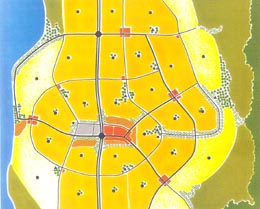On October 13, 1964, the Board of County Commissioners adopts a new Comprehensive Plan to plan and coordinate growth and land-use development in King County. The Plan wins national recognition by relying primarily on detailed policy statements, rather than a land use map, for guiding land development. It adopts an "Urban Center Development Concept" that it defines as an intermediate alternative to "Centralization" and "Dispersion" (sprawl) concepts.
Comprehensive Plans
King County adopted its first unquestionably valid "comprehensive zoning plan" in August, 1958 (after earlier plans and zoning regulations were called into question by a local court decision). The following year, largely at the behest of King County officials, the state Legislature adopted a new Planning Enabling Act that expanded and clarified the role of comprehensive plans in county planning efforts.
In July 1959, the King County Commissioners created a Planning Department as authorized by the Planning Enabling Act and the Department set to work on the studies necessary to prepare a new comprehensive plan. The first step was to prepare a land use inventory, by classifying and measuring existing land uses, concentrating on the growing urban areas outside of incorporated cities. The urban land-use inventory was completed in 1960, and the following year the department began to analyze the data and develop projections for population growth, land development, and other factors over the next 20 years and more.
In addition to undertaking many studies of its own, the County Planning Department co-operated with local city planning agencies and regional planning bodies. It worked closely with and used studies published by the Puget Sound Governmental Council and the Puget Sound Regional Transportation Study.
A New Approach
With these studies and analyses in hand, the department drafted the new Comprehensive Plan under the supervision of Planning Director Edward B. Sand. After a hearing on May 27, 1964, the Planning Commission approved the draft on June 23 and the Plan went to the Board of County Commissioners for final approval. The Board adopted the Comprehensive Plan at its October 13, 1964, meeting (although it deferred action on one controversial provision, involving business zoning at intersections).
The new Plan took an innovative approach. The department explained, "The Plan differs from previous efforts in its approach to the problems of guiding the development of the County. The principal emphasis is placed on detailed statements of development policy" that tend to remain stable (1965 Annual Report). As one of the nation's first "policy plans" that attempted to define general development goals and policies prior to adopting zoning maps and specific controls, the Plan gained widespread recognition.
The Urban Center Concept
The Plan's many development policies were based on an over-arching concept that the planners called the Urban Center Development Concept. This was explained as an alternative to two other possible concepts. Centralization, with almost all population confined to a single major business and cultural center (Seattle in this case) was rejected as infeasible, partly because considerable decentralized growth had already occurred. Dispersion, or low density "sprawl" throughout the region, was also rejected, because of its negative consequences around the nation:
"Suburban bedroom communities, largely consisting of single-family homes, are sprouting outwards in all directions from metropolitan centers. In some areas, they have developed into miles of monotonous housing with neither a complete range of necessary and desirable urban services nor the broad expanses of open space which help to provide beauty, form and identity within the urban area" (Plan, 26).
Under the Urban Center Development Concept, Seattle remained the "major focal point for primary retail, service, wholesaling, and cultural functions" (Plan, 27). However, both existing towns and cities and new urban centers would also become "focal points for employment, commerce, and cultural activities to serve their own areas" (Plan, 27). Between the urban centers, the Plan envisioned some lower density development along with an open space system providing parks and recreational areas.
The 1964 Comprehensive Plan served as the primary guide to King County land-use policy for the next 20 years, undergoing considerable amendment during that time. As is always the case when forecasting the future, the planners -- although they actually slightly over-estimated the population that King County would reach by 1985 -- did not foresee many problems that appeared during the next two decades, including energy shortages, traffic congestion, pollution, disappearance of farmland, and skyrocketing housing costs. By the late 1970s, the County began to prepare a new Comprehensive Plan, which was adopted in 1985.

